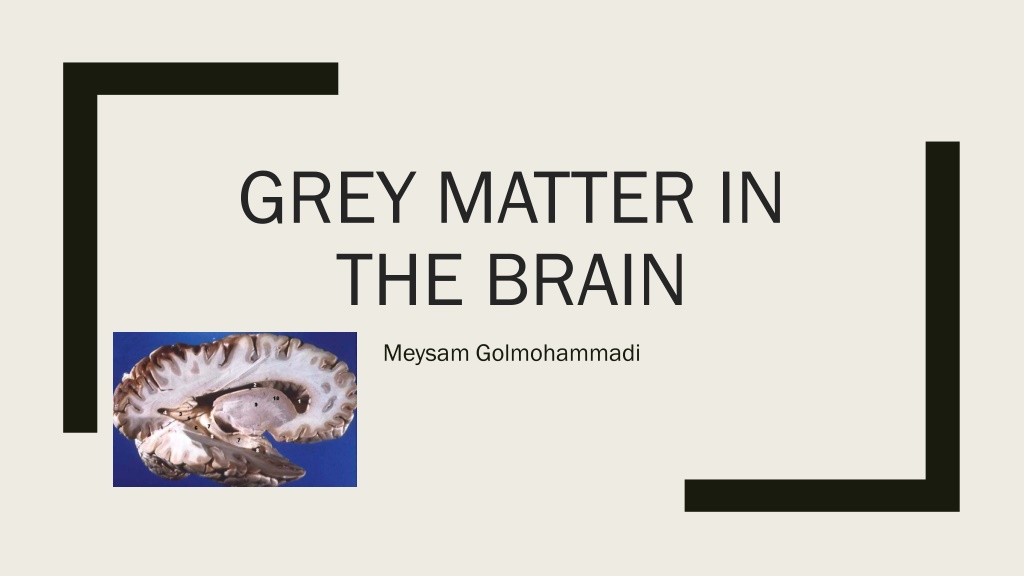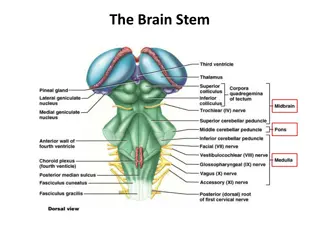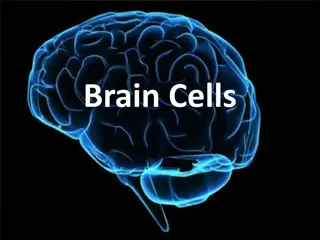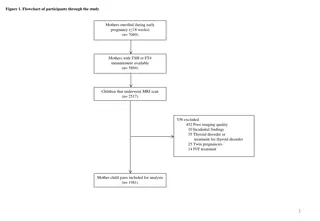Understanding Gray Matter in the Brain: Structure, Function, and Importance
Gray matter in the brain plays a crucial role in information processing and cognitive functions. Composed of neuronal cell bodies and unmyelinated axons, gray matter is visibly pinkish-gray and is essential for various brain functions. It forms a synaptically dense area with fewer cell bodies compared to white matter, which primarily consists of myelinated axons. The distinct color of gray matter comes from capillary blood vessels and neuronal cell bodies. Myelin, a fatty white substance surrounding nerve cell axons, enhances nerve fiber conductivity and is vital for proper nervous system function. Explore the significance of gray matter, white matter, and myelin in brain function and development.
Uploaded on Sep 27, 2024 | 0 Views
Download Presentation

Please find below an Image/Link to download the presentation.
The content on the website is provided AS IS for your information and personal use only. It may not be sold, licensed, or shared on other websites without obtaining consent from the author. Download presentation by click this link. If you encounter any issues during the download, it is possible that the publisher has removed the file from their server.
E N D
Presentation Transcript
GREY MATTER IN THE BRAIN Meysam Golmohammadi
Grey Matter vs. White Matter The central nervous system - CNS - has two kinds of tissue: Grey matter: has a pinkish-grey color in the living brain and is a major component of the central nervous system, White matter: is made of axons connecting different parts of grey matter to each other.
Grey and White Matter Tissues Grey Matter mostly consists of : neuronal cell bodies neuropil : is a broad term defined as any area in the nervous system composed of mostly unmyelinated axons, dendrites and glial cell processes that forms a synaptically dense region containing a relatively low number of cell bodies. glial cells. synapses capillaries. White matter mostly consists of: glial cells myelinated axons
Why Is Gray Matter Gray? The color difference between white matter and green matter is related mainly to the whiteness of myelin. In living tissue, grey matter actually has a very light grey color with yellowish or pinkish hues, which come from capillary blood vessels and neuronal cell bodies. White matter tissue of the freshly cut brain appears pinkish white to the naked eye because myelin is composed largely of lipid tissue veined with capillaries.
Myelin Myelin is a fatty white substance that surrounds the axon of some nerve cells, forming an electrically insulating layer. The thicker the myelin sheath the faster and more efficient the nerve fiber becomes. It is essential for the proper functioning of the nervous system. It is an outgrowth of a type of glial cell. Myelination occurs during the learning process. It allows you to develop skills, like drumming, over time. The more you practice, the more your myelin grows.
Where is Gray Matter The surface of the cerebral hemispheres or cerebral cortex The surface of the cerebellum or cerebellar cortex. Deep within the cerebrum in the hypothalamus, thalamus, subthalamus and in the structures that make up the basal ganglia (the globus pallidus, putamen, and nucleus accumbens). Deep within the cerebellar in the dentate nucleus, emboliform nucleus, fastigial nucleus and globose nucleus. In the brainstem in the red nucleus, olivary nuclei, substantia nigra and the cranial nerve nuclei. In the spinal grey matter including the anterior horn, the lateral horn and the posterior horn.
Gray and White Matter Functions The grey matter includes regions of the brain involved in muscle control, and sensory perception such as seeing and hearing, memory, emotions, speech, decision making, and self-control. Grey matter makes up 40% of brain matter. white matter comprises the other 60%. White matter is composed of bundles of myelinated nerve cell projections (or axons), which connect various grey matter areas (the locations of nerve cell bodies) of the brain to each other, and carry nerve impulses between neurons.























